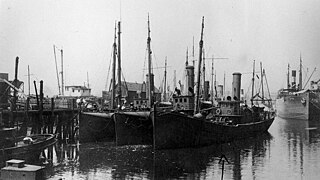USS Captor (PYc-40), briefly the seventh ship to bear the name USS Eagle (AM-132), was a Q-ship of the United States Navy.

USS Speed (AM-116) was an Auk-class minesweeper acquired by the United States Navy for the dangerous task of removing mines from minefields laid in the water to prevent ships from passing.
USS Bateleur (AMc-37) was an Accentor-class coastal minesweeper in the U.S. Navy. She was named after the bateleur, a short-tailed eagle common to eastern Africa.
USS Adamant (AMc-62) was an Accentor-class minesweeper in the United States Navy during World War II.

USS Wassuc (CMc-3), originally a steel-hulled, coastal passenger vessel built in 1924 at Elizabethport, New Jersey, by the New Jersey Drydock and Transportation Corp. of New York City as SS Yale, was acquired by the U.S. Navy on 20 December 1940. SS Yale then began conversion to a coastal minelayer at the New York Navy Yard. Classified CMc-3 on 30 December 1940 and renamed USS Wassuc on 10 January 1941, the ship was commissioned at the New York Navy Yard on 15 May 1941.
USS Bullfinch (AM-66) was a Bullfinch-class minesweeper of the United States Navy during World War II.
USS Catbird (AM-68) was the lead ship of her class of two naval trawlers, which were operated as minesweepers by the United States Navy during World War II.
USS Albatross (AM-71) was an Albatross-class minesweeper of the United States Navy during World War II.
USS Hawk (AM-133) was a Hawk-class minesweeper of the United States Navy during World War II.
USS Kite (AM-75) was the lead ship of her class of minesweepers of the United States Navy during World War II.
USS Nucleus (AM-268) was an Admirable-class minesweeper built for the United States Navy during World War II and in commission from 1943 to 1945. In 1945, she was transferred to the Soviet Union and after that served in the Soviet Navy as T-278. The Soviets converted her into a naval trawler in 1948 and renamed her Uragan.
USS Bluebird (AM-72) was an Albatross-class minesweeper acquired by the U.S. Navy during World War II for clearing minefields during fleet operations.
USS Goldfinch (AM-77) was a minesweeper acquired by the U.S. Navy for the dangerous task of removing mines from minefields laid in the water to prevent ships from passing.
USS Gull (AM-74) was a minesweeper acquired by the U.S. Navy for the dangerous task of removing mines from minefields laid in the water to prevent ships from passing.
USS Chaffinch (AM-81) was a minesweeper acquired by the U.S. Navy during World War II for the dangerous task of removing mines from minefields laid in the water to prevent ships from passing.
USS Puffin (AMc-29) was a coastal minesweeper acquired by the U.S. Navy for the dangerous task of removing mines from minefields laid in the water to prevent ships from passing.
USS Barbet (AMc-38) was an Accentor-class coastal minesweeper acquired by the U.S. Navy for the dangerous task of removing mines from minefields laid in the water to prevent ships from passing.
USS Lorikeet (AMc-49) was an Accentor-class coastal minesweeper acquired by the U.S. Navy for the dangerous task of removing mines from minefields laid in the water to prevent ships from passing.
USS Ostrich (AMc-51) was an Accentor-class coastal minesweeper acquired by the U.S. Navy.

The second USS Ripple (ID-2439) was a United States Navy trawler which served as a minesweeper and was in commission from 1918 to 1919.


